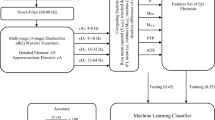Summary
This study analyzes the algorithm by which a distributed system of neurons evaluates specific features in sensory feedback and thereby controls a behavioral response.
The electric fishEigenmannia raises or lowers the frequency,f 1, of its electric organ pacemaker in response to a neighbor's frequency,f 2, which is slightly lower or higher respectively than its own frequency. This Jamming Avoidance Response (JAR) thus serves to increase the difference in frequencies,Δf=f 2−f 1, which is necessary to enhance the animal's electrolocation ability. The JAR is driven by electroreceptive afferences from the individual's electric organ discharges (EODs) which, in different parts of the body surface, are unevenly contaminated by EODs of the other fish. This can be demonstrated, in an open loop experiment, by replacing the silenced, nearly sinusoidal EODs of a curarized fish by a sine wave stimulus,S 1, mixed with a similar stimulus,S 2, which mimicks EODs of another fish. The JAR is controlled by joint modulations of instantaneous phase,H, and amplitude, ¦S¦, of the composite signal,S 1+S2. These modulations, if plotted in a two-dimensional state-plane withH and ¦S¦ as its axes, form a circular graph whose sense of rotation is counterclockwise for positiveΔfs and clockwise for negativeΔfs. The sense of rotation thus determines the direction in which the pacemaker frequency is to be shifted. Modulations ofH and ¦S¦ are encoded by specialized electroreceptors,T- andP-units respectively (Fig. 1).
Applying various forms of artificial computer generated modulations of phase and amplitude, many of which never occur in a natural situation, and by independently stimulating different parts of the curarized animal's body surface, we demonstrate the following:
-
1.
The animal detects a modulation in phase,H, of the stimulus in an area,A, of its body surface by comparing the arrival time,t A , of signals fromT-units in areaA with the arrival time,t B , of signals fromT-units in a different area,B. Differential contamination of the animal's EOD by a foreign EOD in areasA andB will cause a periodic modulation of the interval,t A −t B . No JARs can be elicited without such modulations in at least some parts of the animal's body surface.
-
2.
Increases as well as decreases of the amplitude, ¦S¦ A , of the stimulus in areaA may either accelerate or decelerate the pacemaker, depending upon the momentary value oft A −t B . Amplitude modulations drive the JAR most likely via associated modulations inP-unit activity (Figs. 3–6).
-
3.
The mechanism in (2) is such that, with areaA being more heavily contaminated than areaB, the pattern of joint modulations of ¦S¦ A andt A −t B accelerates and decelerates the pacemaker for negative and positiveΔfs respectively. The respective modulations, ¦S¦ B andt B −t A , in areaB, which yield a graph with a sense of rotation opposite to that in areaA, cause responses which are opposite but smaller in absolute terms than those in areaA. As a consequence, the net effect of this pairwise interaction between areasA andB is a shift in pacemaker frequency in the direction favored by the variables of areaA, ¦S¦ A andt A −t B (Figs. 11, 14).
-
4.
The JAR thus appears to be driven by a distributed system of pairwise interactions between neighborhoods ofT-units on the animal's body surface. These interactions control the effect of local modulations inP-unit activity upon the frequency of the pacemaker. The nature of this system does not require that the animal has any central representation of its own or any neighbor's EOD activity.
The findings in this paper are based on behavioral experiments on basically intact animals. The subsequent paper treats neuronal correlates of the JAR.
Similar content being viewed by others
Abbreviations
- EOD :
-
electric organ discharge
- JAR :
-
jamming avoidance response
- PLLL :
-
posterior lateral line lobe
References
Bastian, J., Heiligenberg, W.: Neural correlates of the Jamming Avoidance Response inEigenmannia. J. Comp. Physiol.136, 135–152 (1980)
Bullock, T.H., Chichibu, S.: Further analysis of sensory coding in electroreceptors of electric fish. Proc. Natl. Acad. Sci. USA54 (2), 422–429 (1965)
Bullock, T.H., Hamstra, R.H., Scheich, H.: The jamming avoidance response of high frequency electric fish. J. Comp. Physiol.77, 1–48 (1972)
Bullock, T.H., Behrend, K., Heiligenberg, W.: Comparison of the jamming avoidance response in gymnotoid and gymnarchid electric fish: A case of convergent evolution of behavior and its sensory basis. J. Comp. Physiol.103, 97–121 (1975)
Feng, A.S.: The effect of temperature on a social behavior of weakly electric fish,Eigenmannia virescens. Comp. Biochem. Physiol.55A, 99–102 (1976)
Heiligenberg, W.: Electrolocation of objects in the electric fish,Eigenmannia (Rhamphichthyidae, Gymnotoidei). J. Comp. Physiol.87, 137–164 (1973)
Heiligenberg, W.: Principles of electrolocation and jamming avoidance in electric fish. Studies of brain function, Vol. 1, pp. 1–85. Berlin, Heidelberg, New York: Springer 1977
Heiligenberg, W., Baker, C., Bastian, J.: The Jamming Avoidance Response in gymnotoid pulse-species: A Mechanism to minimize the probability of pulse-train coincidence. J. Comp. Physiol.124, 211–224 (1978a)
Heiligenberg, W., Baker, C., Matsubara, J.: The Jamming Avoidance Response inEigenmannia revisited: The structure of a neuronal democracy. J. Comp. Physiol.127, 267–286 (1978b)
Knudsen, E.I.: Spatial aspects of the electric fields generated by weakly electric fish. J. Comp. Physiol.99, 103–118 (1975)
Maler, L.: The posterior lateral line lobe of certain gymnotoid fish: Quantitative light microscopy. J. Comp. Neurol.183, 323–364 (1979)
Partridge, B.L., Heiligenberg, W.: Three's a crowd? PredictingEigenmannia's responses to multiple jamming. J. Comp. Physiol.136, 153–164 (1980)
Scheich, H.: Neural basis of communication in the high frequency electric fishEigenmannia virescens (Jamming Avoidance Response). J. Comp. Physiol.113, 181–255 (1977)
Scheich, H., Bullock, T.H.: The role of electroreceptors in the animal's life. II. The detection of electric fields from electric organs. In: Handbook of sensory physiology, Vol. III/3. Fessard, A. (ed.), pp. 201–256. Berlin, Heidelberg, New York: Springer 1974
Scheich, H., Bullock, T.H., Hamstra, R.H.: Coding properties of two classes of afferent nerve fibers: High frequency electroreceptors in the electric fish,Eigenmannia. J. Neurophysiol.36, 39–60 (1973)
Szabo, T.: Anatomy of the specialized lateral line organs of electroreception. In: Handbook of sensory physiology, Vol. III/3. Fessard, A. (ed.), pp. 13–58. Berlin, Heidelberg, New York: Springer 1974
Watanabe, A., Takeda, K.: The change of discharge frequency by A.C. stimulus in a weakly electric fish. J. Exp. Biol.40, 57–66 (1963)
Author information
Authors and Affiliations
Additional information
We thank Dr. John Thorson for his brilliant criticism of our manuscript and Dr. T.H. Bullock for his generous support of our collaboration in the summer of 1978. He, as well as Drs. Brian Partridge, Leonard Maler and Curtis Baker gave most valuable suggestions and criticism. This research was supported by NIMH grant PHSMH-2614904 and NSF grant BNS76-20761 to W.H. and NIH grant R01 NS 12337 to J.B.
Rights and permissions
About this article
Cite this article
Heiligenberg, W., Bastian, J. The control ofEigenmannia's pacemaker by distributed evaluation of electroreceptive afferences. J. Comp. Physiol. 136, 113–133 (1980). https://doi.org/10.1007/BF00656907
Accepted:
Issue Date:
DOI: https://doi.org/10.1007/BF00656907




